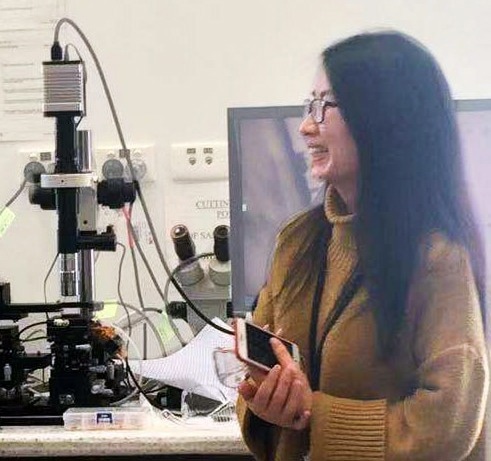A novel, multi-node FLEET review is currently investigating Majorana fermions in iron-based superconductors.
 First author FLEET PhD student Lina Sang in the labs at the Institute for Superconducting and Electronic Materials (ISEM), University of Wollongong. Image Credit: Arc Centre of Excellence in Future Low-Energy Electronics Technologies.
First author FLEET PhD student Lina Sang in the labs at the Institute for Superconducting and Electronic Materials (ISEM), University of Wollongong. Image Credit: Arc Centre of Excellence in Future Low-Energy Electronics Technologies.
The enigmatic Majorana fermion, or “angel particle,” recommended by Ettore Majorana in 1937, behaves like a particle and an antiparticle at the same time — and, interestingly, remains constant rather than self-destructive.
Majorana fermions hold great promise for zero-resistance information and communications technology, which helps to address the rising energy usage of modern electronics (which already accounts for 8% of global energy consumption) and offers a viable future for computing.
Furthermore, the existence of Majorana zero-energy modes in topological superconductors has made them the primary candidate materials for realizing topological quantum computing.
FLEET’s hunt for potential low-energy electronic technologies will be aided by the discovery of Majorana fermions in condensed-matter systems.
The Angel Particle: Both Matter and Antimatter
Fundamental particles like electrons, protons, neutrons, quarks, and neutrinos (referred to as fermions) all have unique antiparticles. The mass of an antiparticle is the same as that of its ordinary partner, but it has the opposite electric charge and magnetization.
When conventional fermions and anti-fermions combine, they form matter and antimatter, respectively, and annihilate one another.
The Majorana fermion is the only exception to this rule, a composite particle that is its antiparticle.
Xiaolin Wang, Study Corresponding Author and Professor, University of Wollongong
Despite considerable searches for Majorana particles, however, the key to its presence has remained elusive for many decades, as its two opposing properties (it has a positive and negative charge) render it neutral, and its interactions with the environment are very vulnerable.
Topological Superconductors: Fertile Ground for the Angel Particle
Despite significant searches in high-energy physics facilities like CERN, the Majorana particle has yet to be found. However, it may prevail as a single-particle stimulation in condensed-matter systems in which band topology and superconductivity live side by side.
In the last two decades, Majorana particles have been reported in many superconductor heterostructures and have been demonstrated with strong potential in quantum computing applications.
Dr. Muhammad Nadeem, University of Wollongong
Nadeem was also a FLEET postdoctorate.
A few years back, a novel type of material known as iron-based topological superconductors was revealed to host Majorana particles without the need for heterostructure fabrication, which is important for implementation in real devices.
Our article reviews the most recent experimental achievements in these materials: how to obtain topological superconductor materials, experimental observation of the topological state, and detection of Majorana zero modes.
Lina Sang, PhD, Study First Author, University Of Wollongong
In these processes, quasiparticles can impersonate a specific type of Majorana fermion, like the chiral Majorana fermion, which moves along a one-dimensional track and the Majorana “zero modes,” which remains constrained in a zero-dimensional space.
Applications of the Majorana Zero Mode
If such condensed-matter systems containing Majorana fermions are experimentally obtainable and can be characterized using a simple technique, researchers would be able to navigate the development of low-energy innovations whose functional requirements are facilitated by extracting the different physical properties of Majorana fermions, like fault-tolerant topological quantum computing and ultra-low energy electronics.
Majorana fermions in topological forms of matter, topological insulators, and Weyl semimetals will be discussed at this month’s major international conference on the physics of semiconductors (ICPS), which will be held in Sydney, Australia.
The IOP 2021 Quantum Materials Roadmap looks into the contribution of intrinsic spin-orbit coupling (SOC)-based quantum materials in topological devices that rely upon Majorana modes, setting out proof at the boundary between powerful SOC materials and superconductors, and also in an iron-based superconductor.
Journal Reference:
Sang, L., et al. (2022) Majorana zero modes in iron-based superconductors. Cell Press. doi.org/10.1016/j.matt.2022.04.021.